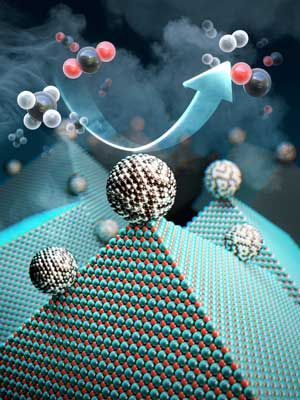Understanding Nanocatalysts: Revolutionizing Chemical Reactions and Industrial Processes
Definition: Nanocatalysts are catalysts that operate at the nanoscale, utilizing particles sized between 1 to 100 nanometers. They are engineered to have a high surface area to volume ratio, significantly enhancing their catalytic activity compared to their macro-scale counterparts. This enhancement is due to the increased surface area available for chemical reactions, making nanocatalysts highly efficient for a variety of industrial and scientific applications.

How Nanocatalysts Work
Nanocatalysts function by providing a platform for reactants to come together more efficiently during chemical reactions. Their nanoscale size allows for a dramatic increase in the surface area relative to volume, which means more active sites are available for reactions. This results in faster reaction rates and higher yields with lower energy consumption and reduced waste production.
Advantages of Using Nanocatalysts
The use of nanocatalysts comes with numerous benefits:
- Increased Efficiency: Their high surface area enhances catalytic activity, allowing for reactions to proceed at much lower temperatures and pressures.
- Cost-Effectiveness: They can often be used in smaller quantities than conventional catalysts while achieving the same or better results, reducing the cost of materials.
- Selectivity: Nanocatalysts can be designed to be highly selective, favoring the production of desired products in chemical reactions.
- Energy Savings: Their efficiency translates to significant energy savings in industrial processes, contributing to more sustainable manufacturing practices.
Applications of Nanocatalysts
Nanocatalysts are utilized across various fields due to their enhanced properties:
- Chemical Manufacturing: They are used to accelerate chemical reactions, making the production of chemicals faster and more efficient.
- Environmental Remediation: Nanocatalysts play a crucial role in breaking down pollutants in water and air, offering a potent tool for environmental clean-up efforts.
- Energy Sector: They are key in developing renewable energy technologies, such as hydrogen production and fuel cells, by improving efficiency and reducing costs.
- Pharmaceuticals: In drug development, nanocatalysts help in synthesizing complex molecules, enabling the creation of new medications with improved efficacy.
Challenges and Future Directions
Despite their potential, the use of nanocatalysts faces challenges, such as ensuring stability during reactions and preventing agglomeration. Ongoing research focuses on developing more robust nanocatalysts and exploring their applications in emerging fields such as nanomedicine and bioengineering. As technology advances, we can anticipate new and innovative uses for nanocatalysts that will continue to transform industrial processes and contribute to advancements in various scientific disciplines.
Further Reading
Journal of Physics: Conference Series, Nanocatalyst: A Brief Review on Synthesis to Applications
Current Opinion in Green and Sustainable Chemistry, Current trends in nanocatalysis for green chemistry and its applications – a mini-review
